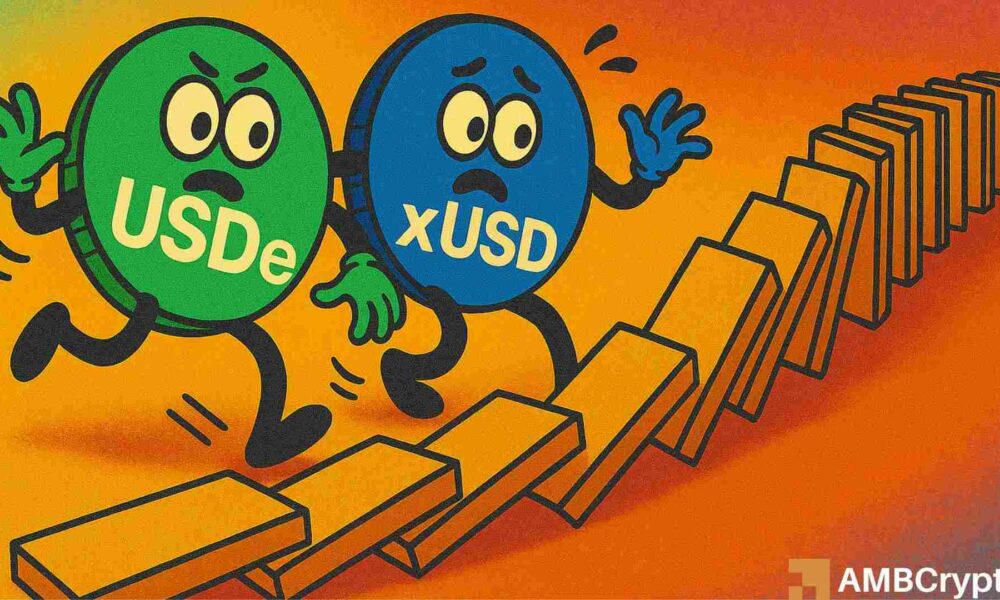The Impact of Synthetic Stablecoin De-Pegs on the Crypto Market
In recent months, the cryptocurrency market has faced turmoil, primarily triggered by the de-pegging of synthetic stablecoins like USDe and xUSD. The events, particularly the crash on October 10, have led to forced liquidations, a DeFi bank run, and significant losses for investors. This article delves into the implications of these de-pegging events, examining how they have reshaped the crypto landscape.
Understanding the De-Peg Event
On October 10, the synthetic stablecoin USDe, which was intended to mirror the U.S. dollar at a 1:1 ratio, plunged to approximately $0.65. This dramatic drop of nearly 40% triggered forced liquidations on platforms such as Binance, further exacerbating market volatility. Fundstrat’s CIO Tom Lee criticized the automatic de-leveraging (ADL) feature, labeling it a "bug" that caused unnecessary harm by failing to effectively utilize price data from multiple exchanges. As traders watched their positions evaporate, almost $20 billion worth of investments were lost, showcasing the fragility of liquidity in the crypto market.
The Ripple Effect on Market Liquidity
The impact of the USDe de-peg extended beyond Binance. Other trading venues, including Hyperliquid, activated their ADL systems to prevent insolvency, resulting in a cascading effect across various platforms and asset pairs. The aftermath of the crash has significantly altered market sentiment, with Bitcoin plummeting below key psychological levels, dropping under $110,000 and struggling to maintain a position above $90,000. The longstanding confidence in synthetic stablecoins has been deeply shaken, forcing a reevaluation of their viability as a stable investment option.
The Aftermath: DeFi Contagion
As the dust settled from the October events, a new crisis emerged on November 4, tied to the synthetic stablecoin xUSD from Stream Finance. Unlike traditional stablecoins, xUSD aimed to generate yields for users through deposit strategies. Unfortunately, many of these strategies proved opaque, leading to about $93 million in asset losses due to an external fund mishap. This revelation triggered panic among investors, and the xUSD’s peg further eroded, demonstrating the inherent risks associated with synthetic stablecoins that lack transparency.
Market Response and Investor Sentiment
In the wake of these crises, investors have become increasingly wary of synthetic stablecoins. The market capitalization of USDe has halved since the October crash, highlighting a systemic shift in investor preference toward more stable and well-audited alternatives. The losses suffered and the subsequent silence from the xUSD team have left many users with significant financial scars. The fear of further contagion has led to a cautious approach among traders, emphasizing the need for reliable data and transparent investment mechanisms.
The Future of Synthetic Stablecoins
As synthetic stablecoins grapple with their identity in the crypto world, the focus is shifting to regulatory frameworks and assurance measures. Investors are seeking better visibility into the mechanisms behind these coins, along with clearer guidelines on their use and risks. The lessons learned from recent de-pegs could lead to innovations aimed at safeguarding liquidity and providing stability, which are crucial for the growth of the DeFi ecosystem. The reputation of synthetic stablecoins hangs in the balance as they navigate these challenges.
Conclusion: A Cautious Outlook
The de-pegging events of USDe and xUSD have ushered in a new era of caution in the cryptocurrency market. As traders and investors process their losses, the future of synthetic stablecoins appears uncertain. Market participants are now more judicious in their approach to investments that promise stability, as the consequences of inadequate risk management become increasingly evident. While synthetic stablecoins have potential, the recent turmoil underscores the importance of transparency and robustness in fostering confidence in this innovative financial landscape.


